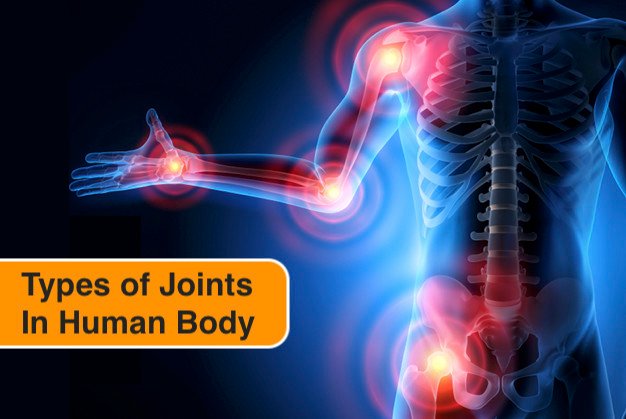How many Joints are in Human Body ?

Locomotion is one of the significant characteristics of CREATURES that differentiate them from other living and non-living things. This is simply because of the bones and muscles present in their body.
Based on the structure of joints, these are classified into three types:
Fibrous Joints
These are the immovable joints where bones are fixed, i.e. not flexible. These joints have no cavity and are joined by connective tissues which are made up of collagen. Example of fibrous joints includes the upper jaw, rib cage, backbone, etc. The skull bones connected by fibrous joints called sutures.
Cartilaginous Joints
These joints are partly movable which allow movement between bones more than a fibrous joint and less than the synovial joint. These are connected by cartilage fibrocartilage or hyaline). These joints provide small mobility between bones. An example includes the joint between the manubrium and sternum.
Synovial Joints
These are prevalent types of joints, and it helps to perform all kinds of movements of the body, such as running, walking, typing, etc. These joints are movable, flexible as well as rotatable. An example includes neck joint, shoulder joint, knee joint, etc.
Based on functions, joints are classified as:
Ball and Socket Joints
It is a kind of synovial joint. In this joint, the ball-shaped surface of one round bone is fitted into the cup-like structure of the other bone. Here the round bone can have movement around an innumerable number of axes around only one axis. Our shoulders are an example of this joint.
Pivotal Joint
It is also known as ‘rotary joint’. It is a movable joint that allows rotary motion around an axis. These joints provide the twisting movement oft bone of the forearm with the upper arm. Example of a pivot joint includes the joint of first and second vertebrae of the neck, which allows the head movement from front to back or back to front. The wrist joint is also a pivot joint.
Hinge Joint
It is a kind of synovial joint which allows movement of bones in one plane. These are made up of two or more articular surfaced bones and are covered by hyaline cartilage and lubricated by synovial fluid. Tissues, muscles and ligament join it. Example of a hinge joint includes the joints of the knee, elbow and ankle.
Saddle Joint
It is a sort of synovial joint which allows movement in two planes. So it is known as a ‘biaxial joint’. Here one of the bones is concave in shape. And the other one is convex. The movement of these joints includes abduction, circumduction, extension. But it does not move axially. An example includes bones of the thumb, the chest and the middle ear.
Condyloid Joint
This joint is also known as ellipsoidal. It consists of an ovoid articular surface which is received into an elliptical cavity. These allow up-down or sideways motion in two planes which includes extension, flexion, circumduction, etc. Examples include the joints of a wrist.
Gliding Joint
It is a prevalent type of synovial joint. It is also known as a planar joint. This joint allows free movement of two or more round or flat bones without any friction. In this joint, the bones glide over each other in any direction. An example includes the joint of the lower leg, ankle and forearm to the wrist.
Get Free “Winspire Digital Worksheets of worth Rs. 129 Value”
Please enter your details to get the monthly E – Booklet + absolutely premium content to expand your horizons.


